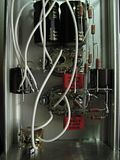tomb
Member of the Trade: Beezar.com
- Joined
- Mar 1, 2006
- Posts
- 10,890
- Likes
- 1,051
Quote:
No, we're specifically avoiding that. Only a small 1/8" hole is required. The MOSFETs are mounted with Bergquist flow pads on the underside of the case lid, then the heat sinks are attached to the same screw with some heat sink grease between the bottom of the sinks and the top of the case lid. Another screw is added through an 1/8" hole to lock the heat sinks in place and keep them from turning. It's really pretty simple and keeps everything inside. I know no one has had an apparent problem, but 48V is enough to pack a good jolt if one comes into contact with it under the right circumstances. The PCB may introduce a lot more people with less experience to the SSMH. After all, building one P2P sort of requires you to think about these things anyway. On the other hand, a PCB is sort of paint-by-numbers and allows people to relax more than they should, perhaps.

Quote:
This is just my own opinion, but you might want to get them detached from the case if you can. They'll definitely reach a much higher temperature than "free-floating" if the heat sinks are attached to the case. There's basically just liquid in many of these caps, anyway.
Quote:
Well, those look plenty big to me. Again, those temps you measured are not outside of normal for MOSFETs - they can get hotter, for sure. You may even find that things will cool down a bit if you case it up. MOSFETs have a positive temperature coefficient, so they may cool slightly when cased up.

| Originally Posted by zkool448 /img/forum/go_quote.gif If the heatsink is efficient enough, then theoretically the FETs can be mounted directly to the heatsink if you cut two small hole on top of case? (keep case panel/internals cool) 
|
No, we're specifically avoiding that. Only a small 1/8" hole is required. The MOSFETs are mounted with Bergquist flow pads on the underside of the case lid, then the heat sinks are attached to the same screw with some heat sink grease between the bottom of the sinks and the top of the case lid. Another screw is added through an 1/8" hole to lock the heat sinks in place and keep them from turning. It's really pretty simple and keeps everything inside. I know no one has had an apparent problem, but 48V is enough to pack a good jolt if one comes into contact with it under the right circumstances. The PCB may introduce a lot more people with less experience to the SSMH. After all, building one P2P sort of requires you to think about these things anyway. On the other hand, a PCB is sort of paint-by-numbers and allows people to relax more than they should, perhaps.

Quote:
| Originally Posted by JamesL Hey, I haven't been on head-fi on a while, but I picked up on this project yesterday - This was my first P2P, and also my first tube project, so it was a big relief when nothing blew up. I haven't yet hooked up any audio, but the tubes are giving off a nice glow. I'm a little worried about the capacitors though. The aluminum case itself gets pretty hot because the heatsinks are cold-welded directly onto it. The capacitors were glued directly onto the case. Would this be alright? The Muse KZ and pana PW's I think are both rated at 85 degrees |
This is just my own opinion, but you might want to get them detached from the case if you can. They'll definitely reach a much higher temperature than "free-floating" if the heat sinks are attached to the case. There's basically just liquid in many of these caps, anyway.
Quote:
| Originally Posted by tamasic1 Quote:
http://bellsouthpwp2.net/k/a/karlet/MySSHA.jpg |
Well, those look plenty big to me. Again, those temps you measured are not outside of normal for MOSFETs - they can get hotter, for sure. You may even find that things will cool down a bit if you case it up. MOSFETs have a positive temperature coefficient, so they may cool slightly when cased up.





























